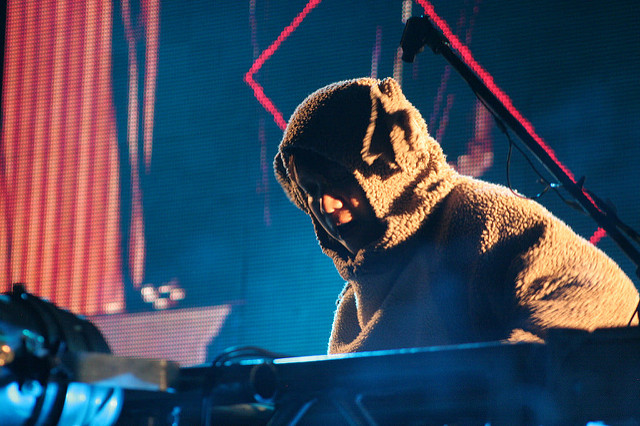Scratch DJ and music producer releases new album, Music to Draw to: Satellite
Making eccentric sounds on turntables for decades, Eric San — known by his artist name Kid Koala — is a renowned scratch DJ, music producer and graphic novelist. On Jan. 20, he released his new album, Music to Draw to: Satellite, alongside singer-songwriter Emiliana Torrini. The album is nothing like his previous scratchy, high-energy sounds. Instead, San explores a harmonious and melodic side of mixing. His soft, dream-like ballads accompanied by Torrini’s delicate voice create the ideal soundtrack for productivity and creation. Kid Koala’s Satellite concert will take place at Montreal’s Centre Phi between Feb. 1 and 4. The shows will be live, interactive experiences where everyone in the audience can play along on turntables.
San began playing music at the age of four, and said he recalls his first live show—a piano recital—as if it happened yesterday. “I was so nervous it was crazy. It was the longest 90 seconds of my life,” said San. At only 12 years old, he discovered the scratch scene. “It was an instant personal interest in how the mechanics of that whole craft worked,” San said. The first time he heard something that blew his mind, he was at a record store. “I didn’t know what the person was using to make these sounds. I walked up to the clerk and he told me that they were doing this on turntables,” said San. Since then, he became fascinated and wanted to recreate such sounds.
“It was an epiphany, one that I haven’t grown out of since I was 12,” said San. With turntables, there wasn’t any sort of structure yet, he said. The DJs he would listen to were only about 10 years older than him. It was a young scene, he said. “The ethos which I still carry very close to my heart is that whatever you did on the turntables, you had to make it fresh,” said San. Keeping it fresh meant you had to have your own personality twisted into the music, even if you used other people’s records, he said. “It had to be your own style and, at the DJ battles, it was all about that. You had to come out and do something different, and I loved that,” said San.
In 1996, Kid Koala released his first mixtape, Scratchcratchratchatch. It was this tape that kickstarted his musical career. While San was studying at McGill University, he dropped off five of his mixtapes at Montreal’s record store, Taboo Inc. In one week, his tapes sold out so he brought more. “That started happening at all these different shops and I eventually got a record deal with Ninja Tunes thanks to this cassette,” said San.
Kid Koala has been long experimenting with different types of scratching and sounds. His first 10 years of scratching were high energy, rhythm percussion and dance floor oriented. “I was trying to keep it very moving and noisy,” said San. From 1996 to 2006, San began touring with bands around the world. He’s toured with Radiohead, Beastie Boys, Arcade Fire and A Tribe Called Quest. “I had to figure out ways to blend my music, and it didn’t always require percussive scratching. It was more about doing what fits and helps the purpose of the song,” said San.
On his tours with Radiohead and Beastie Boys, San would watch how both groups performed. He said the way the artists played their instruments for certain types of songs would vary. “I remember taking notes all the time, trying to figure out what it was that made a specific part they played important and interesting to the song,” he said. That was when Kid Koala’s approach changed, as he started practicing his melody and harmony scratching. “I took a more classical approach after a while because I realised that one of the powerful devices of music is melody and harmony, and it can be a very emotive way of playing,” said San.
After touring the world, 250 cities per year of constant nightclubs and music festivals, San started thinking of doing different types of shows. He wanted to see if there was another utility for music other than making people dance. In 2003, he released his first graphic novel, Nufonia Must Fall, which came with a soundtrack CD. In 2009, he released his second book and soundtrack, Space Cadet. Later that year, San started hosting music event called “Music to Draw to.” The event’s first edition took place at Théâtre Sainte-Catherine in Montreal. “I have a few select records that I call ‘drawing albums’ that I can play on repeat and just lose track of time,” said San. According to San, the whole idea of this event was to keep the soundtrack at a level where people stay in a more meditative state that enables creativity. The event became a template for his new album, Music to Draw to: Satellite, where San experiments with ambient sounds.
Emiliana Torrini, an Icelandic singer, sang and wrote most songs on Music to Draw to: Satellite. “She flew in from Reykjavik to Montreal to work on this album with me. Her voice is the most comforting sound. She is one of my favourite singers,” said San. Torrini and San came up with a narrative story together that shaped the whole album. It started with an article Torrini had read about a wife signing up for a Mars mission trip, leaving Earth and her husband behind forever. “We started exploring this article in theory, what it meant metaphorically and it became the backbone narrative for these imaginary characters that we were going to create and write for the album,” said San.
The release of this album is far from the end of San’s journey, he said. He is still striving for more.“I don’t think I found my voice but it continues to be the tool that drives me along,” said San.
